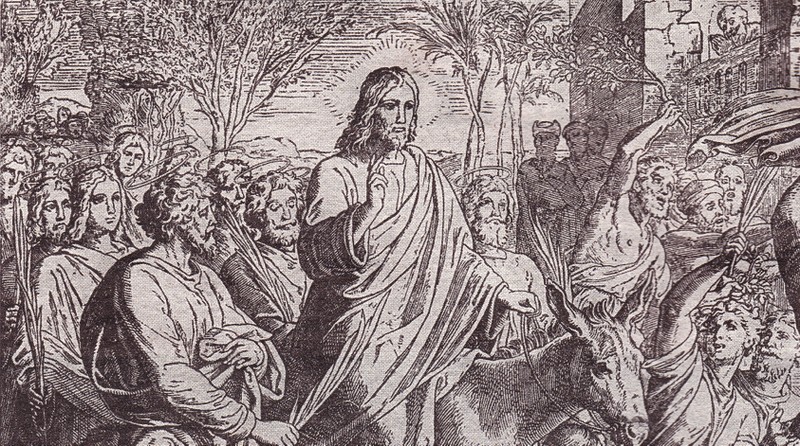
“They took palm branches and went out to meet him, shouting, ‘Hosanna!’ ‘Blessed is he who comes in the name of the Lord!’ ‘Blessed is the king of Israel!’” (John 12:13 NIV)
Just as the details of God’s word are significant, so are the words and actions of Jesus when He walked the earth. Fully God and fully man, Jesus came to defeat death on the cross in order to save mankind. Many biblical greats had come before Him, but none could complete the will of God but His only Son. Palm Sunday was an extremely significant day in the life and ministry of Jesus Christ. Nearing the end of His earthly journey, His full identity as Messiah began to be revealed.
Photo Credit: © Getty Images/azerberber

1. What Is Palm Sunday?
“Rejoice greatly, Daughter Zion! Shout, Daughter Jerusalem! See, your king comes to you, righteous and victorious, lowly and riding on a donkey, on a cold, the foal of a donkey.” (Zechariah 9:9 NIV)
Palm Sunday celebrates the day Jesus entered the Holy City of Jerusalem, where the rest of His ministry would take place. He chose specifically to ride into the city on a donkey, welcomed by crowds waving palms and shouting “Hosanna!” “Jesus’ entry into Jerusalem as King, which inaugurates Passion Week, is a deliberate Messianic action, and the clue to its understanding is found in Zechariah 9:9,” states the NIV Study Bible, “Jesus purposefully offers himself as the Messiah, knowing that this will provoke Jewish leaders to take action against him.” The crowd that welcomed Jesus into the city was familiar with His miracles and teachings. Many of them had most likely been following Him, and shouted “Hosanna! Blessed is he who comes in the name of the Lord, even the King of Israel!” Jesus did not deny their calls to identify Him, confirming His kingship.
Photo Credit: © Flikr

2. When Is Palm Sunday?
Palm Sunday is the start of Holy Week, also called Passion Week, annually celebrated on the Sunday before Easter. This year, Palm Sunday will be celebrated on April 5th, 2020. As we study this day in Biblical history, it’s important to note that many didn’t realize or appreciate the prophetic fulfillment of Jesus’ Messiahship until after His crucifixion.
Holy Week traditionally celebrates the last week of Jesus’ earthly life before His crucifixion, beginning with Palm Sunday. Many churches pass out palms and read the story of Jesus’ entry into the Holy City. Throughout the week, believers reflect on the last day of Jesus’ life leading up to the crucifixion, many attending Maundy Thursday services to celebrate the Last Supper and Jesus’ washing of His disciples’ feet. On Good Friday, we recall the horrific death of our Savior on the cross. Holy Saturday, Jesus remained in the tomb. However, on Easter Sunday, just seven days after Jesus’ triumphal entry into the Holy City, we celebrate His resurrection!
Jesus, fully God and fully man, came to defeat death. Later, He would ascend to heaven to sit at the right hand of His Father, but His Holy Spirit would come and remain in every believer until He returns for us once more. The living God, in us. The curtain of the temple was torn upon His death, and God’s presence made available to all who call Him Savior.
Photo Credit: © Getty Images/toeytoey2530

3. Where is Palm Sunday found in the Bible?
Jesus fulfilled many Old Testament prophecies through His birth, life, death, and resurrection. The entire Bible tells the story of our Savior. The events of Palm Sunday are found in both the Old Testament and the New Testament. The following Old Testament Scriptures speak prophetically of the events of Palm Sunday:
“They quickly took their cloaks and spread them under him on the bare steps. Then they blew the trumpet and shouted, Jehu is king!” (2 Kings 9:13 NIV)
“Rejoice greatly, Daughter Zion! Shout, Daughter Jerusalem! See, your king comes to you, righteous and victorious, lowly and riding on a donkey, on a colt, the foal of a donkey.” (Zechariah 9:9 NIV)
“Lord, save us! LORD, grant us success! Blessed is he who comes in the name of the LORD. From the house of the LORD we bless you.” (Psalm 118: 25-26 NIV)
Jesus’ fulfillment of the Old Testament Scriptures on Palm Sunday is recorded in all four New Testament Gospel Accounts: Matthew 21:1-11, Mark 11:1-11, Luke 19:28-44, and John 12:12-19. Not every scene or teaching of Jesus’ life is recorded in all four Gospels. This makes the detailed appearance of the events Palm Sunday in each account extremely significant.
Photo Credit: © Wikipedia

4. The Significance of Palm Branches
“Many people spread their cloaks on the road, while others spread branches they had cut in the fields.” (Mark 11:8 NIV)
The branches in Mark’s gospel account are “‘leaves’ or ‘leafy branches,’ which were readily available in nearby fields,” the NIV Study Bible explains, “Only John mentions palm branches, which may have come from Jericho, since they are not native to Jerusalem.” John wrote, “They took palm branches and went out to meet him” (John 12:13a NIV). John’s specification of the branches as palm branches is significant. Palms were symbols of Jewish nationalism (NIV Study). People waved them as a sign of victorious celebration.
Ezekiel describes many palm trees inscribed on the temple in his vision: “From the floor to the area above the entrance, cherubim and palm trees were carved on the wall of the main hall” (Ezekiel 41:20 NIV). Repetition throughout Scripture is intentional, and here as we study Palm Sunday, “They took palm branches and went out to meet him, shouting, ‘Hosanna!’” (John 12:13 NIV). What’s more, John mentions palm branches again in the book of Revelation, this time we will wave them in celebration of Jesus’ return! “After this I looked, and there before me was a great multitude that no one could count, from every nation, tribe, people and language, standing before the thrown and before the Lamb. There were wearing white robes and were holding palm branches in their hands” (Revelation 7:9 NIV).
Photo Credit: © Getty Images/Azerberber

5. The People Expected a Messiah, but Jesus Was an Unexpected Kind of Kings
“When Jesus entered Jerusalem, the whole city was stirred and asked, ‘Who is this?’” (Matthew 21:10 NIV)
Those in the crowd with little knowledge as to who Jesus was wondered who entered the city with such royal pomp and circumstance! Throwing robes on the ground, waving palm branches—all were signs of welcoming royalty. “Lowly” in Zechariah 9:9 meant gracious or merciful (NIV Cultural Backgrounds). Calling Jesus the Son of David meant some of the people knew He was the Messiah. Different from kings and conquerors who rode into the city on a horse, Jesus choose a peaceful procession into Jerusalem.
Mark recorded the crowd’s response in his Gospel account: “Blessed is the coming kingdom of our father David!” (Mark 11:10a NIV) The Messiah had been promised by God and foretold by the prophets. The people were expecting a military leader who would conquer their enemies. Jesus rode in on a donkey, which signified peace, not war. They also knew the Messiah would come from the line of David “Hopes for redemption ran high at Passover, and many Judeans interpreted redemption as deliverance from foreign oppression” (NIV Cultural Backgrounds).
Photo Credit: © Unsplash/Avel/Chuklanov

6. Why Did Jesus Ride in on a Donkey?
“As they approached Jerusalem and came to Bethphage and Bethany at the Mount of Olives, Jesus sent two of his disciples, saying to them, ‘Go to the village ahead of you, and just as you enter it, you will find a colt tied there, which no one has ever ridden. Untie it and bring it here. If anyone asks you, ‘Why are you doing this?’ say, ‘The Lord needs it and will send it back here shortly.’” (Mark 1:1-3 NIV)
“The Lord” was Jesus’ way of communicating He is Lord of Israel. He was communicating His divinity, and assuming his authority as a king to have permission to sequester an animal. Jesus rode a donkey to fulfill Zechariah 9:9: “Rejoice greatly, Daughter Zion! Shout, Daughter Jerusalem! See, your king comes to you, righteous and victorious, lowly and riding on a donkey, on a colt, the foal of a donkey” (NIV).
Again, Jesus was an unexpected king. One of humility and peace, not military triumph. The donkey colt symbolized Jesus’ Davidic royalty. Matthew mentions the mother donkey traveling alongside her colt, significant because the colt would not have been weaned yet. “Animals never before ridden or yoked were often those preferred for dedication to God (Numbers 19:2; Deuteronomy 21:3; 1 Samuel 6:7)” (NIV Cultural Backgrounds). Jesus chose an animal that could not even be parted from his mother yet! What a picture of our dependance Him. “Jesus chose to enter Jerusalem this time mounted on a donkey to claim publicly the he was the chosen Son of David to sit on David’s throne, the one about whom the prophets had spoken” (NIV Study Bible).
Photo Credit: © Getty Images

7. What Does “Hosanna” Mean?
The crowds knew Psalm 118:25-26 by heart: “Lord, save us! LORD, grant us success! Blessed is he who comes in the name of the LORD. From the house of the LORD we bless you” (NIV).
Hosanna is a cry or request for salvation and deliverance, traditionally sung at Passover. It means, “Save!” “As a leader, Jesus would be held responsible for the crowd’s acclamations unless he corrected them,” NIV Cultural Backgrounds Study Bible explains, “Public opinion often held teachers accountable for their disciples’ behavior.” Jesus did not refute the claims of the crowds waving palms and covering the ground with their robes. He did come to save. Not just the ones who recognized who He was, but those whose feet would not hit the earth for centuries to come. Hosanna! Save! Jesus did save. He came to obey and fulfill the will of His Father, successfully dying on the cross. What looked like failure to the crowds as it was happening, and maybe even to us today, actually defeated death forever.
The temple curtain, which separated the people from God’s presence, was torn at Jesus’ death on the cross. No longer are we hopelessly chained to our sin. Our Savior has come. He has risen. Hosanna has come! Hallelujah! He reigns.
Meg writes about everyday life within the love of Christ as an author, freelance writer and blogger at Sunny&80. Her first book, “Friends with Everyone,” is available on amazon.com. She earned a Marketing/PR degree from Ashland University, but stepped out of the business world to stay at home and raise her two daughters. Besides writing, she leads a Bible Study for Women and serves as a Youth Ministry leader in her community. She lives in Northern Ohio with her husband, Jim, and two daughters.
Photo Credit: © Getty Images
Originally published Tuesday, 24 March 2020.










